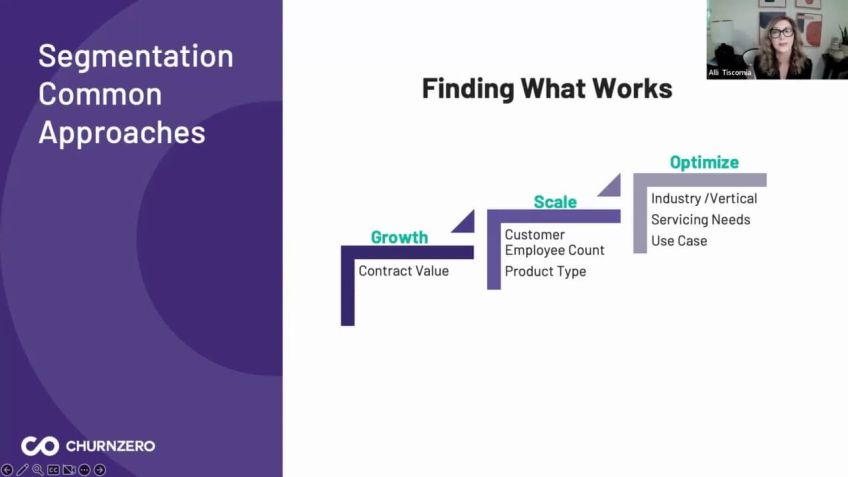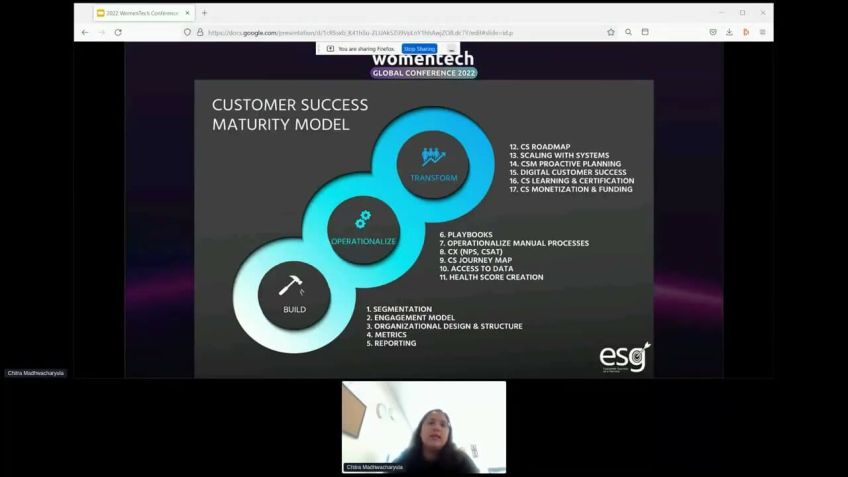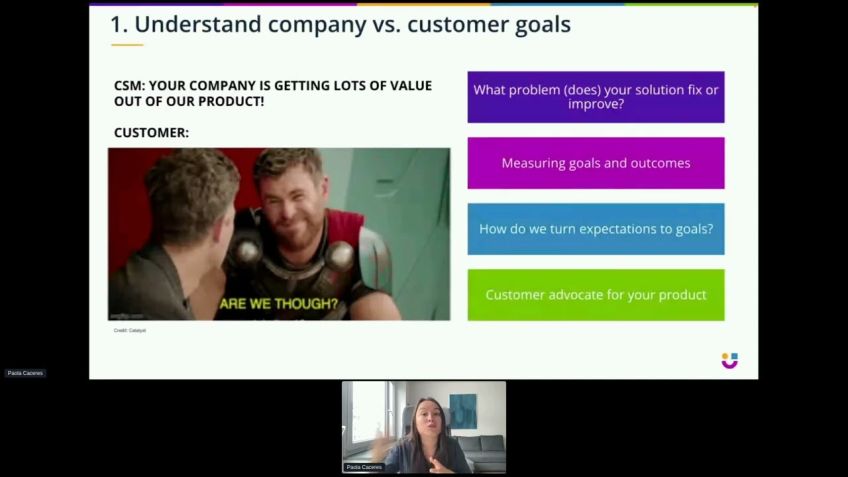Chitra Madhwacharyula A Consultative approach to Problem Solving and Customer Success
A Consultative Approach: The Way to Successful Customer Engagement
Hello everyone! My name is Chitra Mawa Sharia, the head of Global Customer Success and services at Jovi O Inc, a global leader in the recruitment tech advertising space. We believe being a good consultant to your customers and stakeholders benefits you, your customers, and your company immensely. Today, let's dive into how adopting a consultative approach can add value to your engagement with your audience and stakeholders.
How does a Consultative Approach Benefit Everyone?
Adopting a consultative approach positions you as a trusted advisor to your customers, enabling you to guide them through their current pain points, and anticipate potential future issues. What’s the advantage for customers? They get access to an expert they trust who provides actionable guidance. This approach builds your credibility and trust faster with your target audience, translating to better results and more engaged customers, ensuring your professional success.
What is Consulting?
In theory, consulting involves giving expert advice. But in practice, it's about being trusted to guide others from their current state to a desired one. This position offers you tremendous power and influence in your interactions. As Uncle Ben advised Peter Parker a.k.a. Spiderman, “With great power comes great responsibility.” Essentially, this is what consulting is all about.
Understanding Your Customer
- Decision Makers: Typically members of the leadership team who make the final decisions
- Day-to-day users: Those who can influence decision-makers with their feedback on your products
- Your champions: Genuine supporters who have experienced value from your products and services in the past and trust in the value you provide.
It's crucial to understand your target audience in your customer’s team, their expectations and their definition of a successful outcome from your engagement.
Building a Consultative Mindset
Building a consultative mindset involves shifting from short-term, transactional thinking to an outlook that is strategic and big-picture focused. You make the transition from being a vendor to becoming a partner and trusted advisor. A good starting point is by putting yourself in your customer's shoes. This reframes how you apply your problem-solving mindset to add value to your customers.
The growth to aim for is not your own or your company’s but that of your customer. Your growth or expansion will be a by-product of your customer's success. Ask well-thought-out questions that understand your customer’s overarching goals and needs, then provide clear and actionable guidance.
Cultivate a consultative mindset by focusing on why the client is looking to buy or has bought your product. What are their main motivations or drivers? Understand the company culture, history, fears, and goals. Identify the main stakeholders and assess current and future customer needs. Earn your customer's trust by becoming an expert not only in your own products and services but also in your customer's domain. This will enable you to effectively guide them on how they can achieve the best possible outcomes with your products and services.
Finally, remember the importance of building trust and empathy for your customers. If your customers like you, they will listen to you. But if they trust you, they'll do business with you. Feel free to connect with me on LinkedIn for more insights.
Video Transcription
Thank you so much for uh joining. My name is uh Chitra Mawa Sharia. I'm the head of uh global Customer Success and services at Jovi O inc Jovi O is a global leader in the recruitment tech advertising space.And our mission is to deliver the right job for everyone which becomes especially important in these surreal times that we are living through. Right? So today, I'll be talking about how a consultative approach and mindset can benefit a customer success professional. Although this session is in the context of customer success and and and the function can include account, management, consulting, professional services, customer education support and so on. But honestly, you can apply to any function to improve your engagement with your audience and stakeholders, both internal and external.
By the way, if you have any questions, please enter them in the chat window, we only have about 20 minutes, but I'll try to get to at least some of them time permitting. And you're also more than welcome to contact me via linkedin. So before we dive in, let's spend a few minutes to understand why adopting a consultative approach is beneficial and what's in it for you being a good consultant to your customers and stakeholders is beneficial for you, your customers and your company. And that's because from your company's perspective, it puts you in that trusted advisor relationship with your customers where you can not only guide customers regarding their current pain points, but also the anti be able to anticipate potential future gaps that you can help close using your company's products.
From a customer's perspective, they get access to an expert, they trust who approaches their situation holistically and provides actionable guidance. And what's in it for you? Adopting a consultative approach will help build your credibility and trust that much more faster with your target audience, which translates to better results and more engaged customers, hence ensuring professional success for yourself. So what exactly is consulting, right?
So by its theoretical definition, it means engaging with people to give them expert advice. But what that means from a practical perspective is that you are in a position or perceived to be in a position where people trust you to provide them guidance to move from their current state to a better desired state. So think about that for a minute. If someone has confidence that by listening to your advice and by using your products and services effectively, they will be able to get to a much better state that puts you in such an advantageous position to engage with them, it gives you tremendous power and influence. And as Uncle Ben said to Peter, Peter Parker, A K A spiderman with great power comes great responsibility. And in a nutshell, that is what consulting is all about. So, why do organizations employ consultants? Right. Well, for a few different reasons, like getting validation that they are on the right path when they need specialists or experts in a specific field, they employ consultants or when they need an outsider's perspective or when they like to or when they'd like to outsource some work.
And lastly, even though it might sound a little bit morbid to be able to assign blame. If things go wrong as a consultant, you cannot be truly effective at any of these tasks, except maybe taking the blame, of course, unless you know your clients really well. So a key component of building a close working relationship with customers or clients is to truly understand who they are and their personas and roles. And by the way, although the term client is more common in the consulting practice in the customer success or account management realm, both client and customer are regularly used to refer to customers of an organization. And I could use those terms interchangeably as well during the course of this session, but they mean the same thing. So typically there could be multiple people in your customers, organization with whom you might be interacting. Some could be the day to day users of your products, others could be decision makers with broader strategic interest or they could be members of other functions who have an interest in using or some in cases not using your products or services. So one of the first things that a good consultant does when they take over an account or project is to do due diligence, to understand the company and the stakeholders without having clarity on who your target audience is in your customers team and what they are looking for and what they consider to be a successful outcome from your engagement.
You'll be setting yourself up for failure. So at a minimum, you need to engage and build a relationship with the following people in your customers organization, the decision makers, those who make the final decisions and are typically members of the leadership team the day to day users of your products who can influence the decision makers with their feedback and your champions in the organization.
Those who are your genuine supporters who have seen value from your products and services in the past and have trust in the value that you provide now, above stakeholders might have slightly different expectations with regards to your role as a consultant or as a customer success manager and the ro I that they expect from your organization.
So it's very important to start building these relationships early, so you can plan your engagement strategy accordingly. So you know, taking a step back, what is customer success? Right? Customer success itself is a relatively young function. But customer engagement functions as you know, have been here forever, they're called account management, professional services, customer education, customer support consulting, you name it. And in different organizations, all of these are a subset of these functions make up the customer success orc at a basic level.
Customer success means helping your customers achieve their definition of success by using your products and services. And if you work in customer success, you will be acutely aware that there is no common definition of success, knowing your customers, understanding their requirements and what success means to them and then guiding them down that path and doing it in a repetitive way are key metrics for a customer success organization.
All of these tasks align very closely with what consultants are trying to achieve with their clients. Hence, a lot of the same principles and techniques can be effectively applied by customer success teams as well. And what would it take to adopt a consultative methodology in your day to day work? Well, basically, unless you already have some experience with consulting or have built that skill set, it would require a shift in mindset from being transactional and thinking short term to being strategic and looking at the big picture from being a vendor selling or upselling to your customers, to becoming that partner and trusted advisor from thinking operations or lights on to thinking solutions and growth and how do you do that?
Right? A good way to start is by putting yourself in your customer's shoes when thinking about an issue or a situation and then assess what would be the best way to address it. That would give you a whole different perspective on how to apply your problems solving mindset, to add value to your customers. The growth that you should aim for is not your own growth or your company's growth or expansion for that matter, that growth and expansion would be a by-product of your customer's own success. And that is what you should be aiming for. Also go a little deeper when talking to your customers ask questions and understand their overarching goals, the whys and whats of their situation and needs and then provide appropriate guidance which is actionable and clear with regards to maximizing ro I always document your customers discussions and whatever guidance you provided clearly and share with the customers for future reference.
Also a good way to beef up your consulting skills is to sign up for a customer success or consulting course or certification. All good customer success certifications cover consultative methods and conscious and regular practice of core consulting skills in your day to day, CS M work will help in making that mindset second nature. It's, it's like learning a life skill like how to swim or ride a bike.
Once you become an experienced consultant, that mindset becomes part of who you are and how you do things. It's very hard to unlearn. So in a nutshell, a consulting mindset essentially sets you up to ask the right kind of questions. Focus on the whys and what's why is the client looking to buy or has bought your product? Right? What are the main motivations or drivers? Are they even the right ones? What is the company culture, history, fears, goals. Who are the main stakeholders and decision makers connect the dots and connect the dots Using your experience, not only from your knowledge of this customer, but from the knowledge that has been assimilated across your experience, working with a wide variety of customers. Connect the dots to not only identify and solve the immediate need of that customer, but also what might be coming in the future that you would be that you can see and you can anticipate again because of all your experience uh that you bring from your past, working with your future, with your past customers.
And if you don't have that uh experience, don't worry, you'll build that experience. And with every new customer, you get, get to that much of a better state in terms of anticipating and solving your current customers needs. And by doing that, earn the trust of your customers by becoming an expert in not only your own product and services, but also of your customers domain, then you can guide them effectively on how they can leverage your skills and products to achieve the best possible outcomes.
And it's all about the outcomes folks as you know, and through that process, show them what's in it for them to work with you versus with your competitors. The differentiation that you can create for yourself and your company by being a good consultant for your customers will add enormously to the customer perceived value or C PV that you will generate and this C PV will serve you really well to retain and grow customer loyalty both in good times and bad.
And I'll talk more about what C PV means later. But before that, let me share a couple of real time examples with you and I'll speed up um my narration a little bit uh because I think we are running out of time. Um But hopefully, uh you're following along. So I was working for a company where once we had an issue with our product because of which our customers experienced significant short term losses. The customer leadership team was understandably extremely angry and as their CS M I was in the direct line of fire. So although there was not much I could do on the product side, I took some actions to mitigate the overall situation. Firstly, I apologize to the customer upfront and I was transparent that this was our issue and that I had full recognition of the pain that they were going through. Secondly, I put our executive leadership team uh including our CEO into a call with the customer's leadership team to reinforce uh the seriousness with which we are, we are taking this issue and we are all hands on deck to resolve it. I also did some research regarding how other customers had handled similar situations and came back to this customer with recommendations on what immediate steps they can take to resolve the situation. And they were highly appreciative of that by the way.
And lastly, I put together and shared a detailed plan and road map with the customers on the steps we were internally taking to make sure that this does not happen again. The end result was that although the actual value the customer got from our product went down drastically for the short term, our relationship with the customer and the customer perceived value did not go down. We still got high NPS ratings from this customer despite the ordeal because they knew that we were their partner and we're doing our very best to help them. And while we were in the middle of the situation, one of the key leaders in the customers arg told me, don't worry, we are in this together, which was huge for me because it was a testament that for them, we were the trusted partners and not excuse me. Be mere vendors. Story two, I was once sent to do a reviewer analysis for a big high tech customer who was very unhappy with my company and their product. The chief complaint was nobody likes using this product, it's not effective, et cetera. And my goal was to do a thorough analysis and create a report with short mid and long term recommendations to improve the situation and avoid certain customer churn.
What I discovered after two days of talking with the stakeholders and trying to debug usage issues was that the main issue was a lack of communication between two of their internal teams who had differing agendas on how they wanted to use the products. Because of the tension both refused to talk to each other and hence product adoption was suffering as a neutral outsider. I was able to get them both into the same room and help them come up, come to an agreement by providing the path to desired outcomes that satisfied both the teams and mind you. This was one of my first jobs. So I was not a very senior member of the team. Anyway, the results were the result was my primary customer. The decision maker was super happy. My sales rep was even happier and it resulted in a happy ending. There might be other situations where things might not end very happily. But despite that, if you adopt a consultative mindset and build that trust with the customer, I think there is all you will maintain that lifelong relationship with the customer. And even if they churn for the short term, the probability of them returning becomes very, very high. So anyways coming back to my examples.
If you noticed in both the examples, what I tried to do was to be empathetic to the customer's situation and went the extra mile to truly understand what the customer's actual pain and issue was and helped in fixing or mitigating it despite whether it was actually my company's or my art products issue or not.
And what that did is that it strengthened my relationship as a trusted advisor and increased the customer's perceived value from my company. Customer perceived value is now widely recognized as a critical measure that influences customer loyalty. It's different from the quantitative tangible Roy that the customer gets from the usage of your company's products and services. CPD is the value that the customer perceives to be getting from you and your company, which could be higher or lower than the actual Roy along with the quantitative RO IC PV is also based on qualitative measures such as emotional, social and cultural factors. A key player in building C PV is your ability to build that trusted advisor relationship with your customer where they trust your word and your guidance. Adopting a consultative approach sets you apart and plays a key role in increasing your C PV with your customers. Something that will come in very handy when things go wrong because they do go wrong, right? But adopting a consultative mindset and approach helps you maintain that high C PV, despite the issues and usually the result is that your customer relationship is that much more resilient and stronger because they consider you a trusted partner who is with them through the good and bad, not a vendor who's, who's just out to sell them something and move on.
I'd like to end by re emphasizing the importance of building trust and having empathy for your customers. Both of which are key for your successful entry and engagement. Because if your customers like you, they'll listen to you. But if they trust you, they'll do business with you.
And with that, I end my presentation and I think we are right on time. Um I'm sorry, we don't have time for questions, but please feel free to connect with me on linkedin. Thank you.





